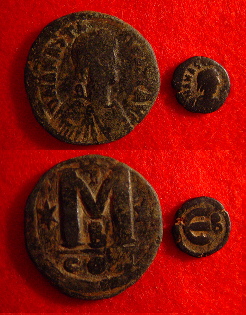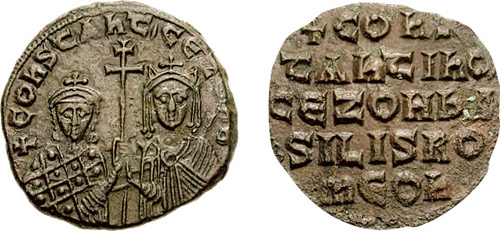follis on:
[Wikipedia]
[Google]
[Amazon]
 The follis (plural ''folles''; , ) was a type of coin in the Roman and
The follis (plural ''folles''; , ) was a type of coin in the Roman and
 The term ''follis'' is used for a large
The term ''follis'' is used for a large

 The term "follis" is used for the large bronze coin denomination (40 nummi) introduced in 498, with the coinage reform of Anastasius, which included a series of bronze denominations with their values marked in
The term "follis" is used for the large bronze coin denomination (40 nummi) introduced in 498, with the coinage reform of Anastasius, which included a series of bronze denominations with their values marked in
A close look at a follis by Doug Smith
Follis Coin Catalog information and details
{{Byzantine coinage Coins of ancient Rome Numismatics Coins of the Byzantine Empire 294
 The follis (plural ''folles''; , ) was a type of coin in the Roman and
The follis (plural ''folles''; , ) was a type of coin in the Roman and Byzantine
The Byzantine Empire, also known as the Eastern Roman Empire, was the continuation of the Roman Empire centred on Constantinople during late antiquity and the Middle Ages. Having survived the events that caused the fall of the Western Roman E ...
traditions.
Roman coin
 The term ''follis'' is used for a large
The term ''follis'' is used for a large bronze
Bronze is an alloy consisting primarily of copper, commonly with about 12–12.5% tin and often with the addition of other metals (including aluminium, manganese, nickel, or zinc) and sometimes non-metals (such as phosphorus) or metalloid ...
Roman coin
A coin is a small object, usually round and flat, used primarily as a medium of exchange or legal tender. They are standardized in weight, and produced in large quantities at a mint in order to facilitate trade. They are most often issued by ...
denomination introduced by Diocletian in about 294. The term "nummus" is now thought to be the actual ancient term, but usage of "nummus" has not caught on. At first the follis weighed about 10 grams and was about 4% silver, with a thin layer of silver on the surface. Over the next decades it declined both in size and in silver content.
The word ''follis'' means bag (usually made of leather) in Latin, and there is evidence that this term was used in antiquity for a sealed bag containing a specific amount of coinage. It has also been suggested that the coin was named Follis because of the ancient Greek word "φολίς" meaning a thin layer of metal (''cf.'' Latin ''folium Folium (, "leaf"), plural folia, may refer to
* a leaf of a book: see recto and verso
* Folium of Descartes, an algebraic curve
* Folium (spider), a marking on the abdomen of a spider
Brain anatomy
* Folium (brain)
* Folium vermis
Botany
* ...
'', "leaf
A leaf (: leaves) is a principal appendage of the plant stem, stem of a vascular plant, usually borne laterally above ground and specialized for photosynthesis. Leaves are collectively called foliage, as in "autumn foliage", while the leav ...
") which covers the surface of various objects, since originally, this coin had a thin layer of silver on top. The 'follis' of Diocletian, despite efforts to enforce prices with the Edict on Maximum Prices
The Edict on Maximum Prices (Latin: ''Edictum de Pretiis Rerum Venalium'', "Edict Concerning the Sale Price of Goods"; also known as the Edict on Prices or the Edict of Diocletian) was issued in 301 by Diocletian. The document denounces greed ...
(301), was revalued and reduced as time passed. By the time of Constantine the Great
Constantine I (27 February 27222 May 337), also known as Constantine the Great, was a Roman emperor from AD 306 to 337 and the first Roman emperor to convert to Christianity. He played a Constantine the Great and Christianity, pivotal ro ...
, it was smaller and barely contained any silver. A series of Constantinian bronzes was introduced in the mid-4th century, although the specific denominations are unclear and debated by historians and numismatists. They are referred to as AE1, AE2, AE3 and AE4, with the first being the largest (near 27 mm) and the last the smallest (averaging 15 mm) in diameter. Namely:
Discoveries
Large hoards of folles have been discovered all across the Roman empire. For example, in Seaton Down, Devon, England, near the site of a second- to third-century Roman villa and fortifications, 22,888 ''folles'' were found in 2013. Fourth century ''folles'' represent the largest category of coin finds in the United Kingdom. Between 30,000 and 50,000 exceptionally well-preserved ''folles'' from the first half of the fourth century were discovered in the sea near the north-east shore ofSardinia
Sardinia ( ; ; ) is the Mediterranean islands#By area, second-largest island in the Mediterranean Sea, after Sicily, and one of the Regions of Italy, twenty regions of Italy. It is located west of the Italian Peninsula, north of Tunisia an ...
in 2023.
Byzantine coin

 The term "follis" is used for the large bronze coin denomination (40 nummi) introduced in 498, with the coinage reform of Anastasius, which included a series of bronze denominations with their values marked in
The term "follis" is used for the large bronze coin denomination (40 nummi) introduced in 498, with the coinage reform of Anastasius, which included a series of bronze denominations with their values marked in Greek numeral
Greek numerals, also known as Ionic, Ionian, Milesian, or Alexandrian numerals, is a system of writing numbers using the letters of the Greek alphabet. In modern Greece, they are still used for ordinal numbers and in contexts similar to those ...
s.
The fals
The fals (; ) was a medieval copper coin first produced by the Umayyad Caliphate (661–750) beginning in the late 7th century. The name of the coin is derived from the ''follis'', a Roman coinage, Roman and later Byzantine coinage, Byzantine ...
(a corruption of ''follis'') was a bronze coin issued by the Umayyad
The Umayyad Caliphate or Umayyad Empire (, ; ) was the second caliphate established after the death of the Islamic prophet Muhammad and was ruled by the Umayyad dynasty. Uthman ibn Affan, the third of the Rashidun caliphs, was also a membe ...
and Abbasid
The Abbasid Caliphate or Abbasid Empire (; ) was the third caliphate to succeed the prophets and messengers in Islam, Islamic prophet Muhammad. It was founded by a dynasty descended from Muhammad's uncle, Abbas ibn Abd al-Muttalib (566–653 C ...
caliphate
A caliphate ( ) is an institution or public office under the leadership of an Islamic steward with Khalifa, the title of caliph (; , ), a person considered a political–religious successor to the Islamic prophet Muhammad and a leader of ...
s beginning in the late 8th century, initially as imitations of the Byzantine follis.
See also
* Trifollaro, a medieval coin worth 3 ''folles'' * Falus, former Moroccan coin * Fils, modern subdivision of certain Arab currenciesReferences
Sources
* * *External links
A close look at a follis by Doug Smith
Follis Coin Catalog information and details
{{Byzantine coinage Coins of ancient Rome Numismatics Coins of the Byzantine Empire 294